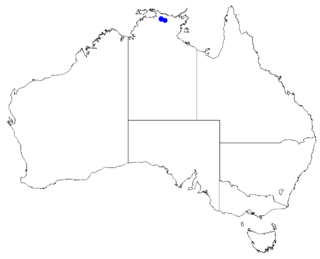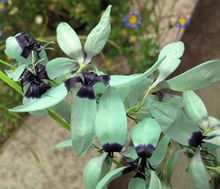
Fynbos is a small belt of natural shrubland or heathland vegetation located in the Western Cape and Eastern Cape provinces of South Africa. This area is predominantly coastal and mountainous, with a Mediterranean climate and rainy winters. The fynbos ecoregion is within the Mediterranean forests, woodlands, and scrub biome. In fields related to biogeography, fynbos is known for its exceptional degree of biodiversity and endemism, consisting of about 80% species of the Cape floral kingdom, where nearly 6,000 of them are endemic. This land continues to face severe human-caused threats, but due to the many economic uses of the fynbos, conservation efforts are being made to help restore it.

A wildflower is a flower that grows in the wild, meaning it was not intentionally seeded or planted. The term implies that the plant is neither a hybrid nor a selected cultivar that is any different from the native plant, even if it is growing where it would not naturally be found. The term can refer to the whole plant, even when not in bloom, and not just the flower.

Strongylodon macrobotrys, commonly known as jade vine, emerald vine or turquoise jade vine, is a leguminous vine endemic to the Philippines. It is a popular ornamental plant known for its cascading clusters of vibrant turquoise or greenish-blue claw-shaped flowers. Cultivating jade vine requires a tropical environment, making it a popular choice in botanical gardens and conservatories. The plant's striking appearance and limited distribution contribute to its allure among plant enthusiasts worldwide.

Babiana is a genus of geophytes in the family Iridaceae with 93 recognized species as of March 2022. The leaves consist of a stalk and a blade that are at an angle to each other. The leaf blades are entire, laterally flattened and pleated, and often hairy. Each individual flower is subtended by two hairy or smooth bracts that are green in most species. The outer bract is often the largest of the two. In most species the bracts have a dry, brown tip, but in a few species it is entirely green or entirely dry when flowering or the outer bract is translucent and has a papery texture. The inner bract is forked or split all the way to its base. Each flower is without a pedicel, with six tepals that are merged at their base into a tube and form a perianth that is mirror-symmetrical in most species, with three anthers implanted where the perianth tube widens and that are, in almost every species, clustered at one side of the style. The style has three branches that widen towards the tip and the ovary is inferior. Flowers occur in almost every conceivable colour, many have markings on some of the tepals, and few star-symmetrical flowers have a centre that strongly contrasts with the free part of the perianth. The majority of these species are endemic to the west and southwest of South Africa, and southwestern Namibia, but one species occurs elsewhere in Namibia and South Africa and another species can be found in Botswana, Namibia, South Africa, Zambia and Zimbabwe. The genus name is derived from the Dutch word baviaan, referring to the Chacma baboon, Papio ursinus, that consumes the corms of plants in the genus. The genus is called bobbejaantjie in Afrikaans, meaning small baboon.

Ixia is a genus of cormous plants native to South Africa from the family Iridaceae. Some of them are known as the corn lily. Some distinctive traits include sword-like leaves and long wiry stems with star-shaped flowers. It usually prefers well-drained soil. The popular corn lily has specific, not very intense fragrance. It is often visited by many insects such as bees. The Ixia are also used sometimes as ornamental plants. The genus is endemic to the Cape Provinces of western South Africa.

Nerine is a genus of flowering plants belonging to the family Amaryllidaceae, subfamily Amaryllidoideae. They are bulbous perennials, some evergreen, associated with rocky and arid habitats. They bear spherical umbels of lily-like flowers in shades from white through pink to crimson. In the case of deciduous species, the flowers may appear on naked stems before the leaves develop. Native to South Africa, there are about 20–30 species in the genus. Though described as lilies, they are not significantly related to the true lilies (Liliaceae), but more closely resemble their relatives, Amaryllis and Lycoris. The genus was established by the Revd. William Herbert in 1820.

The name cardinal beetle typically refers to three different species of beetles. The red-headed or 'common' cardinal beetle is a red to orange beetle with, as the name suggests, a red head. It is about 20 millimetres (0.79 in) long, and is found throughout Britain. The rarer black-headed cardinal beetle, similarly found at sites across Britain, is larger and a deeper blood red. The scarce cardinal beetle also has a black head, but is smaller at around 9 millimetres (0.35 in) long. The scarce cardinal is only found at a few sites in Scotland and Wales.

The turquoise parrot is a species of parrot in the genus Neophema native to Eastern Australia, from southeastern Queensland, through New South Wales and into North-Eastern Victoria. It was described by George Shaw in 1792. A small lightly built parrot at around 20 cm (7.9 in) long and 40 g in weight, it exhibits sexual dimorphism. The male is predominantly green with more yellowish underparts and a bright turquoise blue face. Its wings are predominantly blue with red shoulders. The female is generally duller and paler, with a pale green breast and yellow belly, and lacks the red wing patch.

Protea neriifolia, also known as the narrow-leaf sugarbush, oleander-leaved sugarbush, blue sugarbush, or the oleanderleaf protea, is a flowering plant in the genus Protea, which is endemic to South Africa.
Stylidium longissimum is a dicotyledonous plant that belongs to the genus Stylidium. The specific epithet is from the Latin longissimus, which means "very long" and refers to this species' long capsules that can be up to 15 mm long excluding the sepals. The capsules may be the longest in the genus.
Stylidium oviflorum is a dicotyledonous plant that belongs to the genus Stylidium. The specific epithet oviflorum comes from the Latin ovi meaning egg and florus meaning flower, which refers to this species flower colouration that resembles a fried egg with bright yellow and pure white colours. It is an annual plant that grows from 6 to 26 cm tall. The linear or deltate leaves, about 3-11 per plant, are scattered along the stem and are generally 1.4–3 mm long and 0.25-0.6 mm wide. Petioles and scapes are absent. Inflorescences are 4–15 cm long and produce white and yellow flowers that bloom from April to August in the southern hemisphere. S. oviflorum is endemic to the northern area of Queensland from Mareeba and Wairuna west to Barwidgi. Its habitat is recorded as being sandy soils in seepage areas, on hillsides, or beside creeks in the company of Melaleuca viridiflora, Eucalyptus camaldulensis, or E. cullenii. S. oviflorum is most closely related to S. fissilobum but differs mostly in the corolla colour and self-supporting stems. Its conservation status has been assessed as data deficient.
Stylidium austrocapense is a dicotyledonous plant that belongs to the genus Stylidium. The specific epithet austrocapense refers to this species' native range on the southern part of Cape York Peninsula in Australia. It is an herbaceous annual plant that grows from 9 to 18 cm tall. Oblanceolate or elliptical leaves, about 4-40 per plant, form a basal rosette with stems absent. The leaves are generally 7.5–31 mm long and 2–10 mm wide. This species produces 1-10 scapes per plant that are glandular-hairy. Inflorescences are 9–18 cm long and produce pink or red flowers that bloom from April to July in their native range. S. austrocapense is endemic to the Cape York Peninsula in Queensland, Australia. Its typical habitat has been reported as coarse white sandy soils on low hills or intermittent watercourses. Dominant vegetation in association with its habitat include Eucalyptus tetrodonta, E. clarksoniana, Melaleuca viridiflora, M. nervosa, and Xanthorrhoea johnsonii. S. austrocapense is most closely related to S. multiscapum, but differs by the shorter leaves and absent paracorolla. Its conservation status has been assessed as secure.

The arum lily reed frog, Horstock's arum-frog, arum lily frog, or Horstock's reed frog is a species of frog in the family Hyperoliidae. It is endemic to South Africa.

Ixia maculata is a species of flowering plant in the family Iridaceae known by the common name spotted African corn lily. It is native to the Cape Provinces of South Africa, but it is grown widely as an ornamental plant. It can also be found growing wild as an introduced species in several areas, including Western Australia. This perennial flower grows 20 to 70 centimeters tall with an erect, unbranched stem. There are a few twisting basal leaves up to 35 centimeters long. The inflorescence is a dense, showy spike of up to 12 flowers, usually orange to yellow in color, sometimes with areas of purple or red and often with spots; the coloration in garden plants varies due to breeding.

Iris domestica, commonly known as leopard lily, blackberry lily, and leopard flower, is an ornamental plant in the family Iridaceae. In 2005, based on molecular DNA sequence evidence, Belamcanda chinensis, the sole species in the genus Belamcanda, was transferred to the genus Iris and renamed Iris domestica.

Cassine peragua, also known as Cape saffron, bastard saffron and forest spoonwood, is a medium-sized tree with fragrant flowers, decorative fruits and a saffron-coloured trunk. It is indigenous to the Afro-montane forests of South Africa.

Ixia monadelpha, also known as the pied kalossie or bontkalossie, is an endangered species of geophyte found in wet sandy flats in the southwestern Cape of South Africa.

Boronia viridiflora is a species of shrub that is endemic to a small area in the Northern Territory and grows horizontally from vertical rock faces. The flowers are borne singly or in groups of up to three in leaf axils and are green with a burgundy tinge.

Lachenalia viridiflora, commonly known as the green-flowered Cape cowslip or turquoise hyacinth, is a species of flowering plant in the asparagus family native to the southwest Cape Provinces of South Africa. It was discovered in the 1960s, and first described in 1972 by Winsome Fanny Barker.

Babiana pygmaea is a perennial plant of about 10 cm (3.9 in) high that annually forms leaves and flowers from an underground corm that is assigned to the iris family. It has bowl-shaped, pale yellow flowers with six perianth lobes, purplish in its heart, emerging from a cylindrical tube, and lance-shaped, pleated and heary leafblades that are almost at a right angle with the sheaths. The species can be found in the Western Cape province of South Africa. It is called geelbobbejaantjie in Afrikaans.


















